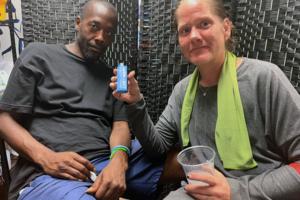Health Advice
/Health

Bird flu threat remains, with one Maryland farm still under quarantine
One commercial farm in Queen Anne’s County remains under quarantine for bird flu, Maryland officials said Wednesday; however, the rest of the state has no such restrictions.
Avian influenza, or bird flu, is a highly contagious airborne respiratory virus that affects poultry — including chickens, ducks and turkeys — as well as some wild ...Read more

NC public health officials urge vaccination as measles cases, flu deaths rise
With multiple measles cases reported in North Carolina, rising flu deaths and shifting federal recommendations, state health officials stressed the importance of vaccination and urged people to contact their health care providers with questions.
“In North Carolina, we are seeing an increase in measles cases, an uptick in respiratory illnesses...Read more

House backs renewing health subsidies, defying Republican leaders
WASHINGTON — Swing-district Republicans defied party leaders to join Democrats in advancing legislation to revive expired Obamacare subsidies for three years, an indication of the political risks facing the GOP majority in the U.S. House heading into this year’s midterm elections.
Nine House Republicans joined Democrats on a procedural ...Read more

Zero-dollar premiums sticking point in Senate health talks
WASHINGTON — A bipartisan group of Senate deal-makers labored toward an agreement Wednesday on reviving expired health care tax credits but are still managing sticking points as the House prepares to vote on a largely symbolic measure backed by Democrats to extend the subsidies for three years.
In a procedural step, the House voted 221-205...Read more

Report: 57 Colorado counties don't meet herd immunity threshold for measles
Colorado measles vaccination rates are falling behind other states, leading to a lower herd immunity among children.
A recent data analysis by The Washington Post found that Colorado has an 88% herd immunity status regarding the measles-mumps-rubella (MMR) vaccine between 2023 and 2024 — well below the 95% threshold set by doctors across the ...Read more

The CDC just sidelined these childhood vaccines. Here's what they prevent
The federal government has drastically scaled back the number of recommended childhood immunizations, sidelining six routine vaccines that have safeguarded millions from serious diseases, long-term disability, and death.
Just three of the six immunizations the Centers for Disease Control and Prevention says it will no longer routinely recommend...Read more

‘Healthy to 100’ author shares secrets from countries where retirees age best
For his new book, “Healthy to 100,” longevity researcher Ken Stern wanted to answer a question that nagged him: Why do so many people in some European and Asian countries live long, healthy lives and how can Americans be like them?
So, for six months in 2024, he traveled to five of the most successful aging nations — Italy, Japan, ...Read more

Environmental Nutrition: The heart of the artichoke
True to its appearance, the artichoke has a bit of a prickly lore.
The folklore
The Ancient Greeks credit Zeus with the creation of the artichoke. As punishment for the deception of his mortal seductress-turned-goddess, he transformed her into the artichoke plant, with spiky petals guarding her resilient heart. The artichoke dates back to the ...Read more

Tips to master the power nap
If you need a quick pick-me-up during the day, a power nap can be just the thing to help restore mental clarity and fight off fatigue. Power naps can help boost productivity and improve your overall well-being, especially when you take them at the right time and for the right duration.
What is a power nap?
A power nap lasts anywhere from 10 to...Read more

Mayo Clinic Q&A: Recognizing the signs of overtraining
DEAR MAYO CLINIC: I’ve taken up running again and decided to enter a half-marathon. I know I have to push myself to get ready for the race, but I don’t want to overdo it. What should I watch out for as I train?
ANSWER: We’re surrounded by warning signs — on the roads, at work, and on packaging and equipment. Your body sends warning ...Read more

Massachusetts deaths from flu rises to four children, with two Boston deaths under two years old
Boston reported two children have died related to the flu this season Tuesday, the first pediatric flu-associated deaths in the city since 2013, bringing total related deaths Massachusetts children up to four.
“We’ve noted a dramatic increase in flu cases in Boston, particularly among children, and we are very concerned about the severity ...Read more

Earlier 911 calls to Rob Reiner's home could loom large in legal battle over son's mental condition
LOS ANGELES — In the years before Rob and Michele Reiner were killed, Los Angeles police made at least two visits to their home in Brentwood.
On Feb. 25, 2019, officers conducted a welfare check after someone called 911 at 9:51 p.m. According to LAPD records reviewed by the Los Angeles Times, officers arrived at the address at 10:12 p.m., ...Read more
'Very high' levels of flu reported in Florida. What to know about what's spreading
MIAMI — South Florida doctors are seeing more people with cough, fever and other flu-like symptoms as a rapidly spreading influenza strain circulates across the country this winter.
Most states in the U.S. reported “high” or “very high” levels of influenza-like illness during the week of Christmas, with a record number of outpatient ...Read more

Children's Hospital Colorado, Denver Health pause gender-affirming care for minors again
DENVER — Children’s Hospital Colorado and Denver Health have suspended gender-affirming hormonal treatments for minors again, though transgender youth can still get care in Colorado from providers that don’t rely on federal funds.
Mardi Moore, CEO of Rocky Mountain Equality, said youth can still seek care from other providers, though ...Read more

RFK Jr. is upending US vaccine policy. This expert says child hospitalizations and deaths will rise as a result
PHILADELPHIA -- Sweeping changes to the United States’ childhood vaccine schedule announced Monday by federal officials will decrease the number of recommended childhood immunizations from 17 to 11.
Outraged pediatricians and infectious disease experts say the move will increase cases of preventable illnesses, hospitalizations, and deaths. ...Read more

Recruiters flew people from Philly to California for what they described as free luxury rehab. Critics say it's a scam.
PHILADELPHIA — Christina Gallo and Daniel Zehnder came to McPherson Square in the Kensington neighborhood looking for a fix, as they did almost every day.
But on this day in late April, an SUV pulled up. A woman bounded out with an offer that sounded like a miracle: an all-expenses-paid trip for free treatment at a luxury rehab center in ...Read more

Medical bills can be vexing and perplexing. Here's important advice for patients
A Texas boy’s second dose of the MMRV vaccine cost over $1,400. A Pennsylvania woman’s long-acting birth control cost more than $14,000.
Treatment for a Florida Medicaid enrollee’s heart attack cost nearly $78,000 — about as much as surgery for an uninsured Montana woman’s broken arm.
In 2025, these patients were among the hundreds ...Read more

Does AI belong in the exam room? Lawsuit alleges Sharp violated patient privacy
A recent lawsuit filed in San Diego Superior Court alleges that Sharp HealthCare recorded conversations between doctors and their patients without written consent, using the information to document visits with an artificial intelligence program developed by a private company in Pittsburgh.
While the lawsuit focuses on one particular medical ...Read more

Study finds sugar substitute could increase risk of stroke
Long thought safe, the sugar substitute erythritol could increase your risk of stroke. Researchers at the University of Colorado, Boulder found that the sweetener impairs certain functions of blood vessels that would otherwise help ease stroke risks.
When exposed to the amount of sweetener in a typical diet drink, the blood vessel cells reacted...Read more

Aging-related weight gain in women: It may start earlier in life than you think
JACKSONVILLE, Fla. — Weight gain is common in women during perimenopause and after menopause, but the physical changes underlying it start much earlier in adulthood. Daniela Hurtado Andrade, M.D., Ph.D., an endocrinologist and obesity expert at Mayo Clinic in Jacksonville, explains why it is important to start counteracting those changes ...Read more








